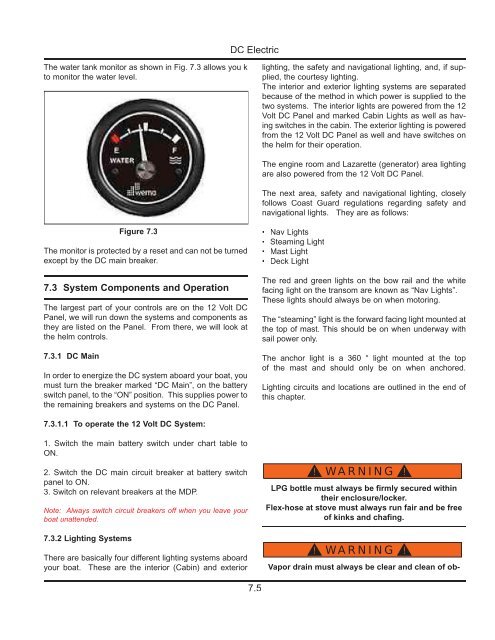36e Operator's Manual 2011.pdf - Marlow-Hunter, LLC
36e Operator's Manual 2011.pdf - Marlow-Hunter, LLC
36e Operator's Manual 2011.pdf - Marlow-Hunter, LLC
You also want an ePaper? Increase the reach of your titles
YUMPU automatically turns print PDFs into web optimized ePapers that Google loves.
DC Electric<br />
The water tank monitor as shown in Fig. 7.3 allows you k<br />
to monitor the water level.<br />
lighting, the safety and navigational lighting, and, if supplied,<br />
the courtesy lighting.<br />
The interior and exterior lighting systems are separated<br />
because of the method in which power is supplied to the<br />
two systems. The interior lights are powered from the 12<br />
Volt DC Panel and marked Cabin Lights as well as having<br />
switches in the cabin. The exterior lighting is powered<br />
from the 12 Volt DC Panel as well and have switches on<br />
the helm for their operation.<br />
The engine room and Lazarette (generator) area lighting<br />
are also powered from the 12 Volt DC Panel.<br />
The next area, safety and navigational lighting, closely<br />
follows Coast Guard regulations regarding safety and<br />
navigational lights. They are as follows:<br />
Figure 7.3<br />
The monitor is protected by a reset and can not be turned<br />
except by the DC main breaker.<br />
7.3 System Components and Operation<br />
The largest part of your controls are on the 12 Volt DC<br />
Panel, we will run down the systems and components as<br />
they are listed on the Panel. From there, we will look at<br />
the helm controls.<br />
7.3.1 DC Main<br />
In order to energize the DC system aboard your boat, you<br />
must turn the breaker marked “DC Main”, on the battery<br />
switch panel, to the “ON” position. This supplies power to<br />
the remaining breakers and systems on the DC Panel.<br />
•<br />
•<br />
•<br />
•<br />
Nav Lights<br />
Steaming Light<br />
Mast Light<br />
Deck Light<br />
The red and green lights on the bow rail and the white<br />
facing light on the transom are known as “Nav Lights”.<br />
These lights should always be on when motoring.<br />
The “steaming” light is the forward facing light mounted at<br />
the top of mast. This should be on when underway with<br />
sail power only.<br />
The anchor light is a 360 ° light mounted at the top<br />
of the mast and should only be on when anchored.<br />
Lighting circuits and locations are outlined in the end of<br />
this chapter.<br />
7.3.1.1 To operate the 12 Volt DC System:<br />
1. Switch the main battery switch under chart table to<br />
ON.<br />
2. Switch the DC main circuit breaker at battery switch<br />
panel to ON.<br />
3. Switch on relevant breakers at the MDP.<br />
Note: Always switch circuit breakers off when you leave your<br />
boat unattended.<br />
7.3.2 Lighting Systems<br />
There are basically four different lighting systems aboard<br />
your boat. These are the interior (Cabin) and exterior<br />
! WARNING !<br />
LPG bottle must always be firmly secured within<br />
their enclosure/locker.<br />
Flex-hose at stove must always run fair and be free<br />
of kinks and chafing.<br />
! WARNING !<br />
Vapor drain must always be clear and clean of ob-<br />
7.5

















